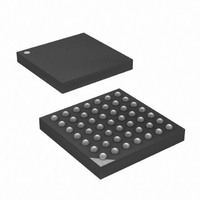ATXMEGA16A4-CUR Atmel, ATXMEGA16A4-CUR Datasheet - Page 206

ATXMEGA16A4-CUR
Manufacturer Part Number
ATXMEGA16A4-CUR
Description
MCU AVR 16+4KB FLASH 49VFBGA
Manufacturer
Atmel
Series
AVR® XMEGAr
Specifications of ATXMEGA16A4-CUR
Core Processor
AVR
Core Size
8/16-Bit
Speed
32MHz
Connectivity
I²C, IrDA, SPI, UART/USART
Peripherals
Brown-out Detect/Reset, DMA, POR, PWM, WDT
Number Of I /o
34
Program Memory Size
16KB (8K x 16)
Program Memory Type
FLASH
Eeprom Size
1K x 8
Ram Size
2K x 8
Voltage - Supply (vcc/vdd)
1.6 V ~ 3.6 V
Data Converters
A/D 12x12b, D/A 2x12b
Oscillator Type
Internal
Operating Temperature
-40°C ~ 85°C
Package / Case
49-VFBGA
For Use With
ATAVRONEKIT - KIT AVR/AVR32 DEBUGGER/PROGRMMRATSTK600 - DEV KIT FOR AVR/AVR32770-1007 - ISP 4PORT ATMEL AVR MCU SPI/JTAG770-1004 - ISP 4PORT FOR ATMEL AVR MCU SPI
Lead Free Status / RoHS Status
Lead free / RoHS Compliant
Available stocks
Company
Part Number
Manufacturer
Quantity
Price
- Current page: 206 of 445
- Download datasheet (6Mb)
19.3
8077H–AVR–12/09
General TWI Bus Concepts
It is possible to disable the internal TWI drivers in the device, and enabling a 4-wire interface for
connecting external bus drivers.
The Two-Wire Interface (TWI) provides a simple two-wire bi-directional bus consisting of a serial
clock line (SCL) and a serial data line (SDA). The two lines are open collector lines (wired-AND),
and pull-up resistors (Rp) are the only external components needed to drive the bus. The pull-up
resistors will provide a high level on the lines when none of the connected devices are driving
the bus. A constant current source can be used as an alternative to the pull-up resistors.
The TWI bus is a simple and efficient method of interconnecting multiple devices on a serial bus.
A device connected to the bus can be a master or slave, where the master controls the bus and
all communication.
Figure 19-1
Figure 19-1. TWI Bus Topology
A unique address is assigned to all slave devices connected to the bus, and the master will use
this to address a slave and initiate a data transaction. 7-bit or 10-bit addressing can be used.
Several masters can be connected to the same bus, and this is called a multi-master environ-
ment. An arbitration mechanism is provided for resolving bus ownership between masters since
only one master device may own the bus at any given time.
A device can contain both master and slave logic, and can emulate multiple slave devices by
responding to more than one address.
A master indicates the start of transaction by issuing a START condition (S) on the bus. An
address packet with a slave address (ADDRESS) and an indication whether the master wishes
to read or write data (R/W), is then sent. After all data packets (DATA) are transferred, the mas-
ter issues a STOP condition (P) on the bus to end the transaction. The receiver must
acknowledge (A) or not-acknowledge (A) each byte received.
Figure 19-2
SDA
SCL
V
CC
illustrates the TWI bus topology.
shows a TWI transaction.
R
P
R
P
DEVICE #1
TWI
R
S
R
S
DEVICE #2
TWI
R
S
R
S
XMEGA A
Note: R
DEVICE #N
TWI
R
S
S
is optional
R
S
206
Related parts for ATXMEGA16A4-CUR
Image
Part Number
Description
Manufacturer
Datasheet
Request
R

Part Number:
Description:
DEV KIT FOR AVR/AVR32
Manufacturer:
Atmel
Datasheet:

Part Number:
Description:
INTERVAL AND WIPE/WASH WIPER CONTROL IC WITH DELAY
Manufacturer:
ATMEL Corporation
Datasheet:

Part Number:
Description:
Low-Voltage Voice-Switched IC for Hands-Free Operation
Manufacturer:
ATMEL Corporation
Datasheet:

Part Number:
Description:
MONOLITHIC INTEGRATED FEATUREPHONE CIRCUIT
Manufacturer:
ATMEL Corporation
Datasheet:

Part Number:
Description:
AM-FM Receiver IC U4255BM-M
Manufacturer:
ATMEL Corporation
Datasheet:

Part Number:
Description:
Monolithic Integrated Feature Phone Circuit
Manufacturer:
ATMEL Corporation
Datasheet:

Part Number:
Description:
Multistandard Video-IF and Quasi Parallel Sound Processing
Manufacturer:
ATMEL Corporation
Datasheet:

Part Number:
Description:
High-performance EE PLD
Manufacturer:
ATMEL Corporation
Datasheet:

Part Number:
Description:
8-bit Flash Microcontroller
Manufacturer:
ATMEL Corporation
Datasheet:

Part Number:
Description:
2-Wire Serial EEPROM
Manufacturer:
ATMEL Corporation
Datasheet:











